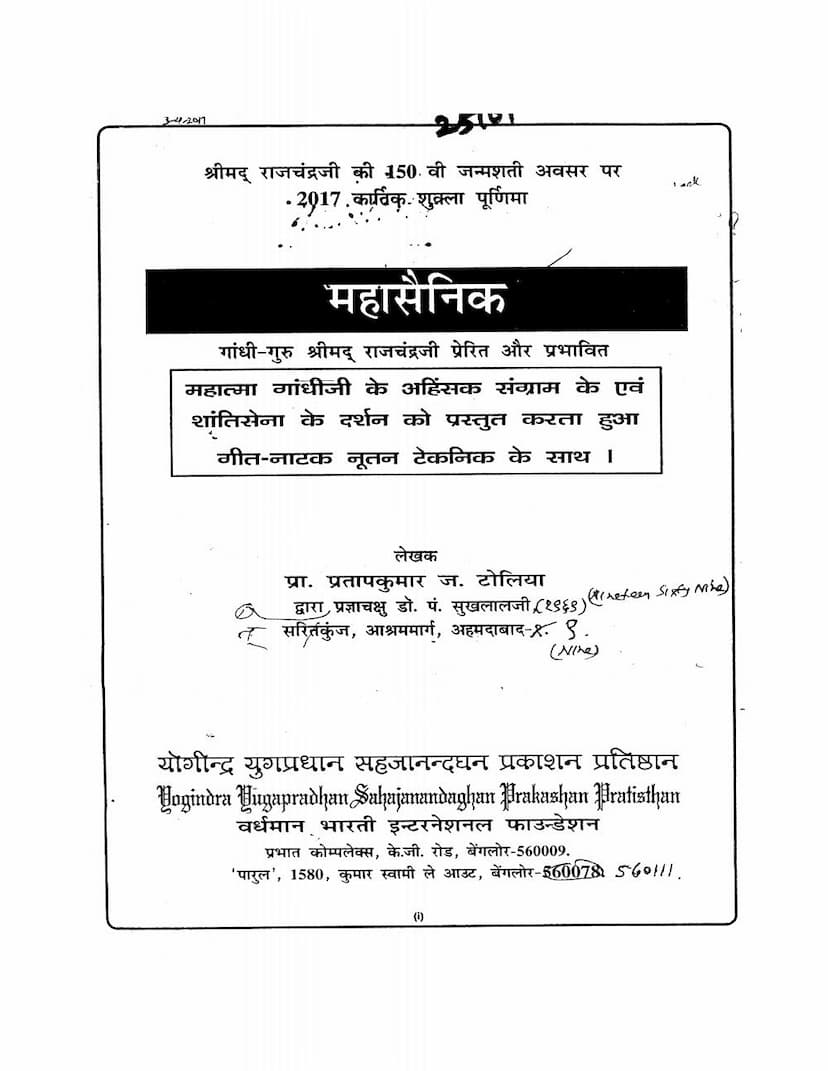Maha Sainik Hindi
Added to library: September 2, 2025

Summary
The provided Jain text, titled "Maha Sainik" (The Great Warrior) by Pratap J Tolia, is a Hindi play that explores themes of non-violence (ahimsa), peace, and the teachings of Mahatma Gandhi and Shrimad Rajchandra.
Here's a comprehensive summary based on the provided pages:
Core Theme and Inspiration:
The play is inspired by and dedicated to the philosophy of Mahatma Gandhi and his non-violent struggle, specifically highlighting the concept of a "Shanti Sena" (Peace Army). It commemorates the 150th birth anniversary of Shrimad Rajchandra, acknowledging his influence on Mahatma Gandhi. The play aims to present a new technical approach to the concept of peace and non-violence.
Narrative Premise:
The story is set in the year 2048 AD, 100 years after Mahatma Gandhi's death, during the Fourth World War. The play contrasts the destructive nature of modern warfare (including space warfare) with the enduring power of non-violence and peace.
Key Characters and Their Roles:
- Budhe Baba (Old Man): A 106-year-old Indian "Shanti Sainik" (Peace Soldier). He embodies the principles of Gandhi's disciplined life. Despite his age and injuries, he is firm, healthy, and dedicated to serving and establishing peace. He carries Gandhi's message and ideals.
- General Whitefield: The highest-ranking military officer of a major Western nation, a decorated hero of the Third World War. He is initially portrayed as strong, courageous, intelligent, and cruel, leading the nation in a technologically advanced and destructive space war.
- Shrimad Rajchandra and Mahatma Gandhi: While not present as characters on stage, they appear in symbolic "dream sequences" or through recorded speeches and their teachings, influencing the characters and the narrative. Shrimad Rajchandra is presented as a key spiritual guide to Gandhi.
- Other Characters: Include Marshal Matthew, Lieutenants, Space Soldiers, Station Controllers, and various soldiers and officials, all contributing to the war and peace narrative.
Plot and Development:
- Act 1, Scene 1: The play opens on a war-torn battlefield. The "Budhe Baba" enters, a symbol of peace amidst destruction, expressing disgust towards weapons and war. He questions the necessity of continuous wars and witnesses the suffering and death of soldiers from all nations. He encounters General Whitefield, who is a celebrated warrior but a perpetrator of destruction. The Budhe Baba challenges the General's actions and introduces the philosophy of Gandhi.
- General's Transformation: General Whitefield, initially dismissive, is gradually impacted by the Budhe Baba's words, Gandhi's teachings (presented through the baba and later through recordings), and personal tragedies (loss of loved ones due to war). He begins to question the purpose and cost of war.
- Dream Sequences and Teachings: Dream sequences reveal Shrimad Rajchandra's spiritual practices, his ability to befriend wild animals (like tigers) through love and non-violence, and his profound influence on a young Gandhi. The text highlights Shrimad Rajchandra as a householder, jeweler, poet, and self-realized soul who guided Gandhi on the path of truth and non-violence.
- Gandhi's Legacy: The play showcases Gandhi's non-violent struggles, such as the Dandi March and the Quit India Movement, emphasizing how he fought without weapons, relying on truth, love, fasting, and non-cooperation. The narrative stresses that Gandhi's success stemmed from his pure means and unwavering commitment to his cause.
- The Tragic Flaw of War: The play powerfully illustrates the destructive nature of war. General Whitefield's nation, through advanced technology, plans a devastating attack on an enemy country, but a critical error leads to the accidental bombing of their own territory, causing immense destruction and loss of life, including the General's own family.
- Realization and Renunciation: This devastating event shatters General Whitefield's belief in violent warfare. He recognizes the futility and self-destructive nature of his nation's actions, recalling the Budhe Baba's words and Gandhi's teachings about the consequences of trying to destroy others.
- Embracing Peace: Profoundly changed, General Whitefield decides to abandon the war program. He chooses to embrace the path of non-violence and peace, inspired by Gandhi and the Budhe Baba. He resigns from his position as a military general and vows to transform his army into a "Shanti Sena" (Peace Army).
- The Meeting and Pledge: The play culminates in a gathering at the Budhe Baba's grave. General Whitefield and his officers pledge to become "Shanti Sainiks" (Peace Soldiers), committing to truth, non-violence, and the service of humanity. They resolve to transform their scientific advancements for creation and coexistence, not destruction.
Technical and Artistic Elements:
The play utilizes various technical elements like stage lighting, music, sound effects, dream sequences, and projections to enhance its message. The use of Gujarati folk songs (like "Dhan re bole ne" and Shrimad Rajchandra's poetry) adds a cultural and spiritual layer. The characters' dialogues and pronouncements often echo the philosophical depths of Gandhi and Rajchandra.
Overall Message:
"Maha Sainik" is a powerful dramatization of the enduring relevance of Gandhi's and Shrimad Rajchandra's teachings in a futuristic, war-torn world. It suggests that true strength lies not in military might but in the unwavering commitment to truth, love, and non-violence. The play offers a hopeful vision of transformation, where even the most hardened warrior can be inspired to embrace peace and become a true warrior for humanity.